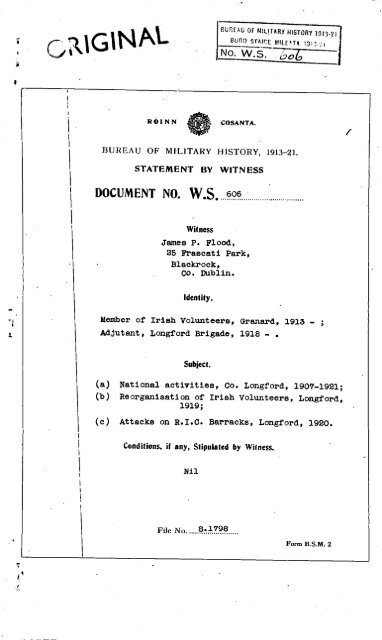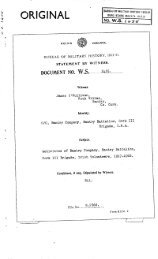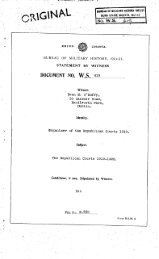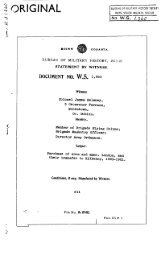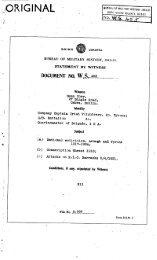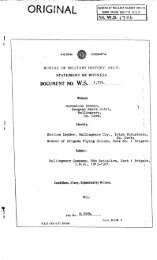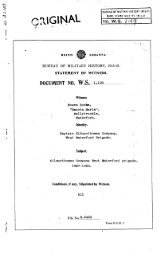ROINN COSANTA. BUREAU OF MILITARY HISTORY, 1913-21 ...
ROINN COSANTA. BUREAU OF MILITARY HISTORY, 1913-21 ...
ROINN COSANTA. BUREAU OF MILITARY HISTORY, 1913-21 ...
Create successful ePaper yourself
Turn your PDF publications into a flip-book with our unique Google optimized e-Paper software.
<strong>ROINN</strong><strong>COSANTA</strong>.<strong>BUREAU</strong> <strong>OF</strong> <strong>MILITARY</strong> <strong>HISTORY</strong>, <strong>1913</strong>-<strong>21</strong>.STATEMENT BY WITNESSDOCUMENT NO. W.S.606WitnessJames P. Flood,25 Frascati Park,Blackrock,co. Dublin.Identity.Member of Irish Volunteers, Granard, <strong>1913</strong>Adjutant, Longford Brigade, 1918Subject.(a) National activities, Co. Longford, 1907-19<strong>21</strong>;(b) Reorganisation of Irish Volunteers, Longford,1919;(c) Attacks on R.I.C. Barracks, Longford, 1920.Conditions, if any, Stipulated by Witness.NilFile No S.1798Form B.S.M.2
Statement by James P. Flood,25 Frascati Park, Blackrock, Dublin.CONTENTSPageFirst contact with Sinn Féin. 1Start of Irish Volunteers in Granard. 11916: Before and after the Rebellion. 2Re-organisation of the Irish Volunteers. 3The "German Plot" and Conscription. 4Re-organisation of Longford Brigade. 5Attacks on Drumlish and Mostrim R.I.C.Barracks. 6Attack on Ballinamuck R.I.C. Barracks. 7Purchase of arms. 8Attack and capture of Ballymahon Barracks. 8-9My arrest and internment. 9Intelligence work in the Longford Brigade. 10
STATEMENT <strong>OF</strong> MR. JAMES P. FLOOD,25 Frascati Park, Blackcock, Co. Dublin formerly ofGranard, Co. Longford.I made my first contact with Sinn Féin when I came homefrom school in 1907. I then joined the branch of theNational Council in Granard. John Cawley, who wasmanager of the local Creamery, was a member. Two otherswhoa I also remember were Cassidy and Kenny who were shopassistants in the town. At this time there was greatopposition to Sinn Féin. This emanated from the UnitedIrish League and the Hibernians. At the. head of theLeague was Mr. J.P. Farrell, M.P., who also owned thelocal paper, the "Longford Leader". Very little headwayor progress was made by the, local branch of Sinn Féinagainst this opposition until some years later when a mannamed William Ganley, who was a very prominent member ofthe United Irish League, broke away from that body andjoined Sinn Féin.Amongst the activities at that time was the collectionof funds for election purposes. Later we organised "Mylesthe Slasher" meetings in Finea to which we brought downspeakers from Dublin, with a view to spreading the lightof Sínn Féin. P.T. Daly and Walter Cole were amongst thespeakers who came down. That more or less covers theactivities up to <strong>1913</strong>.In <strong>1913</strong>, helped by Dr. Brian Cusack, then a medicalstudent and now living in Lusk, we established the IrishVolunteers in Granard and organised the spread of itthroughout Co. Longford. When we had the North LongfordBattalion established, we had a very successful Review
2.and March Past, which was attended by Major Crean. The.only arms we had were one converted Mauser rifle, 22 bore,some shotguns and some sporting rifles. Then the splitin the Volunteers took place.As the vast majority of the local Volunteers at thattime were in sympathy with Redmond's side, we did notprecipitate a split in the local Company. In other words,we allowed the thing to simmer. We were in a position toforce the issue, of course, but we thought that it wouldblow over. The Volunteers in Longford more or less diedout from 1914 to 1916. Our activities were mainlyand there was practically nothing of positiveVolunteer work being done at all. We were very much inthe minority and there was a certain amount of war fevergrasping the country then. In fact, we who stillsupported the Sinn Féin ideal were often called and alludedto as "Pro-Germans".We in Granard were not aware that a Rebellion wasintended until after it started actually on Easter Mondaynight. As we were concerned to know what help if anywe couldgive, john Cawley and Paul Cusack (a brother ofDr. Cusack) set out on Easter Tuesday for Dublin in a carowned and driven by Larry Kiernan, with the object offinding out what was happening there and to getinstructions regarding what we were to do. They returnedthe next day and told us that the Rebellion was well underway, but they did not know what was happening as theycould not get any nearer to the city than Lucan and couldnot contact anyone The only thing we did was to cutsome telegraph wires.john Cawley was at that time the I.R.B. Centre inGranard. I was not then a member but joined later in 1917.I was told afterwards that some sort of message had beensent by Headquarters in Dublin but probably on account of
3.the confusion arising from the countermanding order,nothing was done about it and nothing happened in Longfordwith the exception of the cutting of the telegraph wiresreferred to. Who received the message from Dublinif any ever came-I am not in a position to state.After Easter Week, 1916, John Cawley and Paul Cusackwere arrested and interned in Frongoch Camp. They werethe only two arrested in the Granard area. Presumablytheir arrest was due to the fact that they tried to getinto the city on Easter Monday.At the end of December, 1916, the prisoners werereleased from Frongoch. The Volunteers, however, did notget going again until the Longford election campaign inMay 1917. The victory of the Sinn Féin candidate JoeMcGuinness gave a great boost to Sinn Féin and provideda foundation for building up the Volunteers. In July,1917, after the Clare election, in which I also took part,Mick Collins and Tom Ashe came to Granard and stayed therefor a few days. During their stay, we brought them toBallinalee to hold a public meeting for the purpose ofestablishing a branch of Sinn Féin there. We used SinnFéin as a cover for recruiting and organising theVolunteers. Ashe at first did not want to attend thismeeting as he was tired. He came, however, and made avery fine speech. None of the rest of us could speakwell. Mick Collins also nude a speech but he was not sofluent as Ashe. It was as a result of this speech thatAshe was arrested and imprisoned in Mountjoy, where he diedwhilst being forcibly fed.Around this time, we called a meeting in Granard ofvarious officers from North Longford. Mick Collinsattended and urged upon us the necessity of starting theVolunteers. He said we would have to get moving and getthe organisation going. As far as I can remember, Seán
6.new men who would really be efficient. The Companieswithin the Battalions were also well organised. We got acommunication system working and it ran very smoothly. Wehad Volunteer dispatch riders and other means ofcommunication such as the Cumann na Battalion andmBan.Brigade Council meetings were held regularly.One Brigade officer was always present at BattalionCouncil meetings to see that the work was being carried onefficiently and to check up on activities and see that allinstructions issued by the Brigade had been received andlikewise to see that all reports and such were renderedby the Battalion to the Brigade. I and Seán Connollygenerally attended the meetings of the North CountyBattalions while Reddington and Cooney did South Longford.Nothing of a military offensive activity happened in 1919except active organising work.The first offensive action occurred on the 5/6thJanuary, 1920, when a rather abortive attempt was made totake Drumlish Barracks. I was not there myself and Idon't know who took part in it, but I know that it wasmainly organised by Reddington.When Reddington's wife got very ill, he left theBrigade area and Seán Connolly was acting Brigadier. Anarrangement was made to attack the Barracks inAfter a lot of preparations, we were actually all inposition on the night of the 27th May, 1920, when it wascalled off, as word came that the British military weremoving into the area.In the early months of 1920, we were being pushed veryhard by Mick Collins to do something definite. Thispressure resulted in the abortive attempt on Drumlish andthe attempted attack on Edgeworthstown. Shortly afterthe Edgeworthstown affair, I called over to see ConnollyI think Reddington was still away. This was on a Sunday
7.morning and I asked him what report we would send toHeadquarters regarding our failure to attack Edgeworthstown.He replied, "We will send no report at all". I said, "Wewill have to send a report". He replied, "We will senda report when I have another scheme which is under my hatcarried out". I said, "What scheme?". He then said,"There's too much talk and I'm only going to tell you anda couple of others. I'm going to attack BallinamuckBarracks". I remarked that that was a pretty formidableundertaking and asked him how he was going to do it.He replied that he would take it with four or five men.I laughed at this.I could not see how it could be takenas it was lowtifred four castellated towers.Connolly drew a plan for me and described how he was goingto attack the Barracks.This plan was not submitted to the BrigadeCouneilandSean Connolly alone was responsible for it. He was theman who planned it and to him only must go the credit forit. He and a few others did all the planning andpreparation for the attack. Although Ballinamuck Barrackswas not captured it was completely destroyed and the attackwhich took place on the 9th-lOth June, 1920, was a greatsuccess for it raised the morale and prestige of the I.R.A.in Longford immensely. I think it pleased Mick Collinsvery much because he had been in Ballinamuck and knew whata formidable undertaking it was and the pressure fromHeadquarters eased off after this.The Barracks was rendered untenable to the R.I.C.and was evacuated almost immediately. The Brigade nowstarted planning our next attack. As the police were nowvery active in North Longford, we decided to attackBallymahon R.I.C. Barracks in South Longford. AgainSeán Connolly comes into the picture. Connolly made acomplete reconnaissance of the R.I.C. Barracks, and at a
8.Brigade Council meeting afterwards, he outlined his planfor the attack and capture of it. This plan was approvedby the Brigade but there was the difficulty that we hadnot enough rifles. Up to this we had destroyed BallinamuckBarracks, but had captured no arms This time wewanted to get arms and ammunition We had got somegrenades from Dublin and the ides was that the back of thebarracks would be held by men with those grenades, thusforcing the police to cane out in front on the street.When the plan was originally considered by the BrigadeCouncil it was considered that it was not feasible for thelack of rifles. This was not, however, the fault of theBrigade as we had tried hard to obtain some fromHeadquarters.Some months previous to the attempted attack onEdgeworthstown Barracks, we had collected £37. 10. to getsix rifles at £5 odd each and a hundred rounds ofammunition for each rifle. We had been told byHeadquarters that, if we could provide that money, wewould get them. We sent the money to Dublin by FrankThornton. Frank used to visit. Longford in connectionwith his business the New Ireland Assurance Companyand he was also organising for the I.R.B. When Frankreturned with the "stuff" we found the QuartermasterGeneral had fooled us, as an we got was six revolversfour Webley revolvers at £7.10 each and two 38 revolversat £5 each. What we wanted was rifles; we had enoughrevolvers.At a Brigade Council meeting the question arose as towhat we were going to do about getting rifles in order toattack Ballymahon. It was decided that someone wouldhave to go to Dublin and see the "Big Fella" (Mick Collins)and that he was not to part with the money until he got therifles. Seán McKeon was chosen for this job. Seán went
to Dublin and Saw the "Big Fella". He returned and brought9.back six rifles. He was delighted with himself but,neaticiattywhen we opened them up, we found we had been fooled again.Two of the rifles were 22; the other four were serviceriflesalright.We were now almost on the eve of the attack onBallymahon Barracks and still we had only about six orat Brigade Canalseven service rifles. Some said that the position washopeless as the police would probably spot the positionand we would be sunk. Finally it was decided that wewould have to fall back on the "Geordie" plan. "Geordie"was a deserter from the British Military Barracks inLongford who had come to us a few months previously.He was sent to work for a farmer in the Ballinalee areaand kept under observation by us. He had a plan todisarm the guard in the Top Barracks in Longford. SeánMcKeon, with three others, carried out this operation onthe night before the attack on Ballymahon Barracks,and with the rifles thus obtained the plan to attackBallymahon was completely successful.The attack on Ballymahon Barracks provided theBrigade with all the arms needed, and how wall these armswere used is now well known. For my part I was deniedthe privilege of taking part on any further Brigadeactivities for on the night before the attack I wasarrested by the British Military when returning from aBattalion Council meeting. I was subsequently chargedwith possession of seditious documents and sentenced totwelve months imprisonment from which I was not releaseduntil the Saturday after the Truce in July 19<strong>21</strong>.While I was Adjutant of the Longford Brigade, thechief means of communication with General Headquarterswas through a Miss Skeffington, daughter of thestationmasterin Longford. A lot of it was done through
10.the guards on the trains. They, of course, were railwayofficials. Miss May Maguire, Main Street, Longford, wasan alternative address where communications could also beleft and collected. I do not know who were her contacts.There was no Intelligence officer appointed in theBrigade, and the Brigade Adjutant had to carry out theseduties also. As an Intelligence officer, I was in touchwith a man called Mick Maguire in Mullingar. He wasable to get me copies in cipher of all the police messagespassing through the Post Office in Mullingar. We gotoccasionalonesfrom the Longford Post Office but thebulk of them came from Mullingar. Dublin Headquartersused to send us the key to the cipher, but generally I wasoutable to work it before this arrived. The informationI got in this way related to pending raids, arrests andother information the police had picked up concerning theVolunteers. I did not travel to G.H.Q. concerning anyof these reports.There are in the Archives of the Department of Defencereports and despatches which passed between the LongfordBrigade and General Headquarters.Signed:P. FloodJames(James P. Flood)Date:6thNov1951Witness: Matthew Barry Comdt(MatthewBarry,Comdt.)


